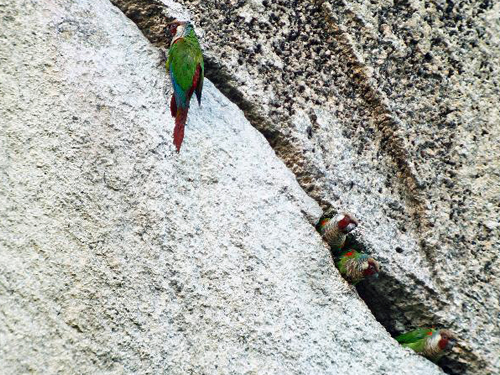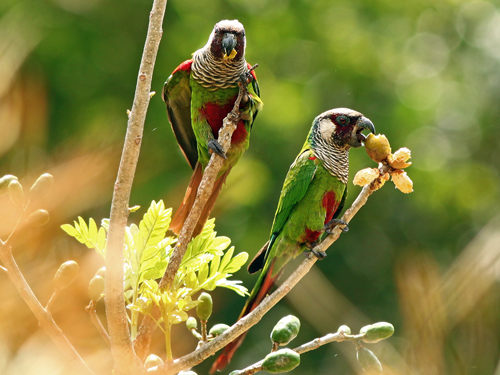 Better in the wild - the gorgeous grey-breasted parakeet. Image by: Fabio Nunes.Researchers supported by the Conservation Leadership Programme have uncovered a small population of grey-breasted parakeets nesting on a mountain in north-east Brazil.
Better in the wild - the gorgeous grey-breasted parakeet. Image by: Fabio Nunes.Researchers supported by the Conservation Leadership Programme have uncovered a small population of grey-breasted parakeets nesting on a mountain in north-east Brazil.
A team of scientists searching for remnant populations of the Critically Endangered grey-breasted parakeet has found a small group nesting in a small crevice on the top of a rugged mountain ridge in north-east Brazil.
Only around 300 of these birds are thought to remain in the wild, all of which are found in the Brazilian state of Ceará.
As part of a national action plan for the species, researchers from local organisation Aquasis have searched more than 20 sites for signs of the parakeet, focusing their efforts on areas identified as having high habitat potential or historical sightings.
 An expedition, supported by the Conservation Leadership Programme, found a group of parakeets nesting in a rocky fissure. Image by: Fabio Nunes.This new discovery brings the total number of known groups up to three. By comparison, historical data show that at least 15 separate populations once existed.
An expedition, supported by the Conservation Leadership Programme, found a group of parakeets nesting in a rocky fissure. Image by: Fabio Nunes.This new discovery brings the total number of known groups up to three. By comparison, historical data show that at least 15 separate populations once existed.
Coffee and cages
The colourful grey-breasted parakeet stands at just over 20 cm tall and is distinguished from similar species by its brown cap, maroon cheeks and red shoulders. Found in tropical mountain forests in north-east Brazil, it feeds on fruit and seeds in the canopy.
This species faces two major threats today: the destruction of its forest habitat (primarily to make room for coffee plantations) and ongoing trapping for the illegal local, national and international pet trade.
Rare beauty
The newly-discovered population consists of just five individuals, some of which are showing deformities.
The long isolation of the different groups has led to genetic differences that only add to the difficulty of saving this species, however.
 Grey-breasted parakeets feed on fruits and seeds. Image by: Fabio Nunes.The animals in each of these populations have their own ‘cultural’ knowledge and genetic adaptations that help them survive in their specific environment. They know where to breed, where to find water and food, how to escape from predators, and so on.
Grey-breasted parakeets feed on fruits and seeds. Image by: Fabio Nunes.The animals in each of these populations have their own ‘cultural’ knowledge and genetic adaptations that help them survive in their specific environment. They know where to breed, where to find water and food, how to escape from predators, and so on.
This therefore raises the question of whether mixing individuals from different groups (to boost the number and genetic diversity in the newly-discovered group, for example) would actually benefit the species, or whether this would simply add more risk.
Given these complexities, the researchers say that the successful conservation of the species will require a mixed approach to conservation that addresses the real and imminent threats while boosting people’s awareness and appreciation of this rare tropical beauty.